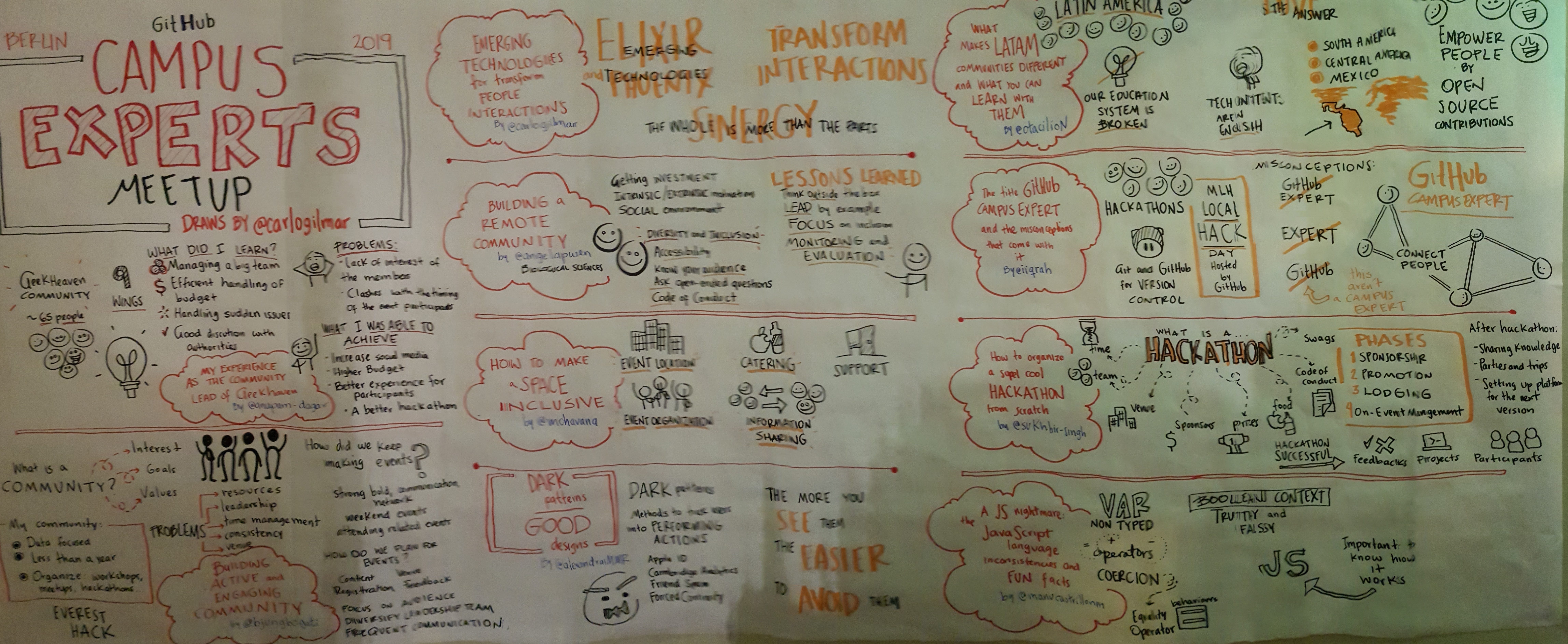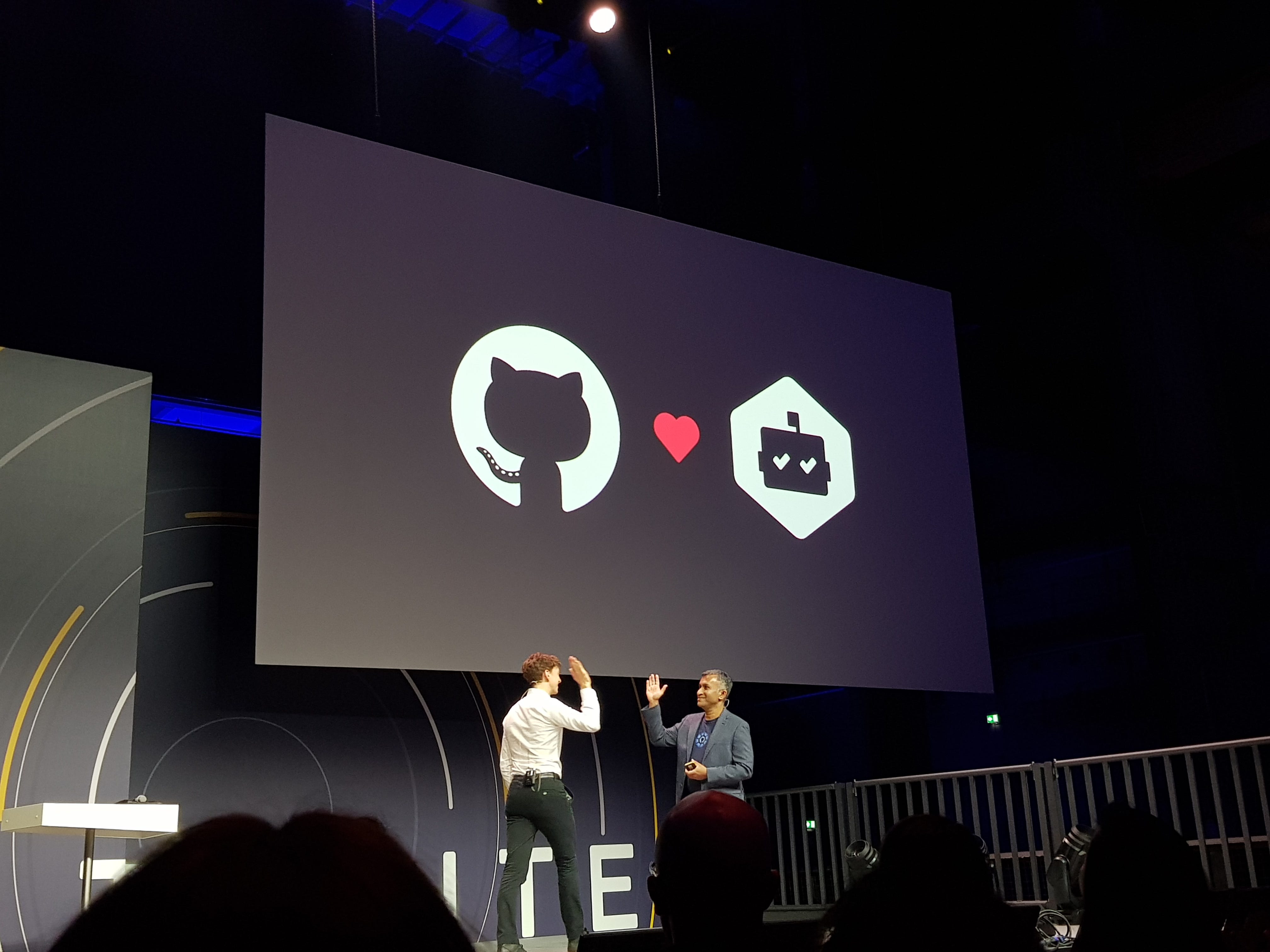My experience attending GitHub Satellite 2019 in Berlin

Recently, I got a chance to attend GitHub Satellite, the conference which brings big ideas and memorable content to cities around the world. From the latest GitHub product news to hands-on workshops, GitHub Satellite brings together thousands of developers to explore what’s next.

It was a phenomenal experience attending the conference. I attended GitHub Satellite as a GitHub Campus Expert, India along with other 10 from different parts of the world. I reached Berlin well in advance of the event and had plenty of time to explore the city. So on the first day, I took the Berlin tour and got to know about the stories related to all the historical buildings there.
As all the campus experts build communities at their campus, it is very difficult for all of us to meet each other and events like these are a good opportunity to talk and get to know about each other. The day before satellite, we had a Campus Experts Meetup where everyone just talked with each other, ate good food and delivered their scheduled lightning talks.
Also, I met super cool Lieke who is the Developer Program Manager for Campus Experts.
Not to mention, sketch notes by Carlosgilmar left everyone amazed.

The talks in the meetup consisted of talks from building communities to organising events, from dark patterns in software to weird things javascript does.


The next day morning, it was the showtime. The conference was at Kraftwerk in Berlin which was nearly half an hour away from where I was staying.
I reached nearly half an hour before the keynote, checked in myself, the GitHub staff at the registration desk handed over me a transparent neon tote bag with a limited edition sticker pack and notepad in it. It was amazing to see that all the details I filled while taking my ticket for the Satellite was inside my attendee card and while interacting with the sponsors, all I had to do was tap my card on their device to give my details to them.
Everyone was on time, no one wanted to miss Nat’s keynote. There was a surprise talk which would mark the closing of the GitHub Satellite, nobody knew what it was until Nat revealed it in his Keynote. Finally the clock struck 9:30 and it was time for the keynote to start.
Nat came on the stage, welcomed everyone to Satellite and continued the keynote.
The keynote was packed with a lot of feature announcements in the area of security, enterprise, and community. Nat told that GitHub calls their 36 million developer users “GitHub home”. After telling about the open source community and that any project currently has an open source dependency, then came the first major breakthrough or should I say the most awaited surprise, Dr. Katie Bouman joined GitHub Satellite via satellite from Boston. A few minutes later, came another surprise, the core team behind the black hole image, Andrew, Kazu, Sarah, C.K, Roman and Lindy joined the keynote on stage. Surprise after surprise came another surprise, out of the 21000 contributors of the full dependency graph for the black hole image, the maintainers and core contributors to Numpy, Matplotlib, Scipy, Astropy, Pandas, Python, Cython, Kiwisolver etc. were attending GitHub Satellite. After all the surprise reveals, then came the turn for feature reveal. At the very first, Nat revealed the community contributors and dependent repository feature which lets one know that how many direct and indirect contributors are there to the project and also by how many people the project is used.

The security features were unveiled by Shanku Niyogi. A partnership with whitesource and dependabot being part of GitHub. Automated security vulnerability fixes via dependabot and security advisory were some of the keyhighlights for security features. Dana Lawson talked about the new features in GitHub Enterprise.

Finally, towards the end, Devon Zuegel came up with the most lovable feature reveal for all, the GitHub sponsors. To sum up the keynote and the final best thing to be revealed, Nat announced GitHub matching fund i.e 200% fund transfer on sponsorship.
After the keynote, there was a break and most of the people started networking. I had a good talk with the sponsors of Satellite, Circle CI, Travis, Whitesource, and Snyk.
The team from Microsoft Azure Devops were running a lab at the venue and also a demo for the azure pipelines.
Throughout the day, I met many people and talked to them. It was great talking to all of them and knowing all the new stuff they had to share. I met the organiser of Slash Hackathon, Slash is a tech community of CODE University of Applied Sciences in Berlin. It is always fascinating meeting other student community leaders and knowing how they handle things and what aim they have for their community.
Next, I got a chance to meet a lot of hubbers from professional services team, from product design team and other teams. I met the incredible Hector Alfaro, who then told me that he has worked closely with the Campus Experts program in its initial phase.
And finally, I met the marvelous Nat Friedman and had a little talk with him about the keynote.

The venue was filled with a lot of cool things to checkout. There was an octocat generator, but yes, it wasn’t any other octocat generator, the octocat generated over here were converted into stickers for you. Interconnected communities room was fascinating, it showed a visualisation of the GitHub followers, the best part about it was how it showed the interconnected communities. The visualisation was in the form of space, every user was a star but the user being checked out was the brightest of all and in the center. Now each follower following me has its set of followers. At the back of these stars, small dots can be seen at a distance representing the interconnection between the user being checked out and the user not following it.

In the conference, I attended Open Source for good session and the closing session “Into The Black Hole” taken by the black hole team. Many of the things from the talk were quite difficult to understand but still it provided me with a lot of new information about the complete process behind the black hole image. It was quite wonderful to know about why the black hole image looks like the way it is. The GitHub Satellite was over with a standing applause to the black hole team after their session.
Then came the afterparty and later on the preparty for the Maintainerati unconference happening next day. During the afterparty, I saw something not seen till now, one of the person was DJing the programmer’s way using Haskell and setting up all the bpm for the music. I didn’t know how it worked but it was unbelievable to see it at first look. After it, all the campus experts clicked a picture and finally it was time to bid adieu to the GitHub Satellite.
Next day it was time for the Maintainerati unconference organised by the GitHub Developer Relations team. The aim was to create an open space for all the developers to hangout, communicate as much as possible and discuss about the opensource issues and how to overcome them. I talked about how to get almost 100 people started with their first pull request and then discussed over what makes a contributor not to become a maintainer. I met Don Wilson here and he was also the space host where I talked about my topic. Don kept making the notes throughout the open space session of the communication happening and notes were basically more to point out the common problems every person face in opensource.


After the Maintainerati, finally the 3 day conference extravaganza came to a halt. Those 3 days are the most memorable days I had till now and its difficult to forget them. It was real great to get so much of knowledge, ideas from each person and to know problems faced by each person in opensource. By talking to other experts, I had a good idea about how different communities have different issues and how they come over it and do different things according to their community.
